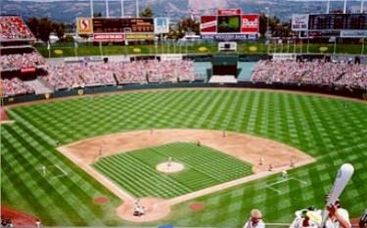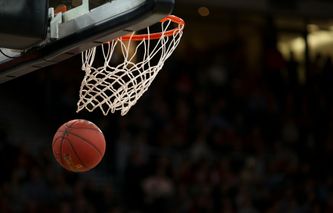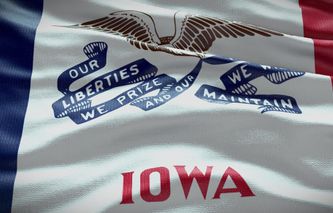
53rd Season
First Game Played April 10, 1968
7000 Coliseum Way, Oakland, CA 94621
(510) 638-4900
http://www.oaklandathletics.com
Historical Moments
1968:On May 8th, in front of the new home fans of Oakland, Jim “Catfish” hunter throws the first regular-season perfect game in 46 years. The move also inspires the team as the young Athletics help the franchise capture their first winning season in 16 years, with an 82-80 record.
1969:Led by Reggie Jackson, who hits 39 home runs in the first half, the Athletics climb into serious contention of the American League’s new Western Division. The youth and inexperience catch up with the A’s, and they fade out of the race. Reggie also fades in the chase for the single-season home run record, as he manages to hit only eight homers in the second half. The A’s do manage to finish in second place with a solid 88-74 record.
1970:In another odd move from eccentric owner Charles O. Finley the Athletics use yellow bases during their home opener; it would be the only time these bases are used, as Major League Baseball bans their use in the future. Meanwhile, the young A’s continue to improve challenging for the division again while posting an 89-73 record.
1971:Owner Charles O. Finley makes the news by giving his players bonuses for growing a mustache. It results in many colorful looks that would be the trademark for the team, including reliever Rollie Fingers’ classic handlebar look. The mustache experiment works as the young Athletics come of age. In his first full season in the majors, Vida Blue wins 24, and strikes out 301, while holding the America League to a league-low 1.83 ERA. Blue’s year earns him both MVP and Cy Young honors. The A’s would go on to win 101 games and cruise to the Western Division Title. However, the young Athletics would fall victim to the experienced Baltimore Orioles in the ALCS as the birds swept the A’s on the way to their third consecutive American League Championship.
1972:Even with Vida Blue struggling to a disappointing 6-10 season, the Athletics are beginning to develop into a juggernaut. The Mustache Brigade, as the press calls them finishes with a 93-62 record, to hold off the Chicago White Sox for their 2nd Consecutive Division Title. In the ALCS, the Athletics face the Detroit Tigers. The A’s, behind strong starting pitching from Catfish Hunter and Blue Moon Odom, jump out to a fast 2-0 lead after two games in Oakland. With the series moving to Detroit, the Tigers win the third game 5-0, and even the series with a three-run explosion in the tenth inning of Game 4. The A’s with their backs to the wall win Game 5, behind the 1-2 punch of Blue Moon Odom and Vida Blue 2-1. However, they suffer a devastating blow as Reggie Jackson injures his leg, and would be unable to play in the World Series. With Reggie Jackson on the shelf, few experts gave the A’s a chance to beat the Cincinnati Reds in the World Series. With Game 1 in Cincinnati, the A’s desperately need someone to step up big. Not much was expected from Gene Tenace, who hit .225 with five home runs in 1972, but Tenace would single handily get A’s off to a flying start, with two HR and three RBI Tenace supplied all the offense as the A’s won Game 1 by a score of 3-2. In Game 2, the A’s once again jumped out to a lead, but with Catfish Hunter tiring in the ninth inning the A’s needed an incredible game-saving catch from Joe Rudi to hold on and take a 2-0 series lead to Oakland. After the Reds took Game 3 pitcher’s duel 1-0, the A’s were in danger of falling into a 2-2 tie late in Game 4. However, four consecutive singles gave the A’s two runs to claim a 3-1 series lead with a dramatic 3-2 win. With a chance to close out the Big Red Machine in Oakland, the A’s had a slim 4-3 lead in the eighth inning of Game 5 thanks to a three-run homer from Gene Tenace, who was having the series of his life. However, the Reds would come off the ropes to score a run in the eighth and another in the ninth inning to send the series back to Cincinnati. Two days later, the Reds would easily win to force a seventh and deciding game. Gene Tenace would be the hero again collecting two RBI singles in the A’s 3-2 Game 7 victory. The win earned the Athletics their first World Championship in 41 years when they were in Philadelphia.
1973:With American League MVP Reggie Jackson winning both the home run and RBI crowns, the A’s claim their third consecutive AL West title with a 94-68 record. In the ALCS, the Athletics were matched up once again with Baltimore Orioles. After losing Game 1, the A’s bounced back to win Game 2 thanks to the hitting and spectacular defense of 3B Sal Bando. Game 3 in Oakland turned into an unforgettable pitcher’s duel between the A’s Ken Holtzman, and Orioles Mike Cuellar. The game went into the 11th inning when SS Bert Camapneris not known for his power hit a dramatic walk-off home run. However, the A’s could not hold a 4-0 lead in Game 4 and were forced to play a fifth and deciding game. In Game 5, the Orioles never had a chance as Jim “Catfish” Hunter simply dominated all game to give the A’s their second consecutive trip to the World Series. In the World Series, the Athletics were matched up against the New York Mets, who made the World Series despite struggling to finish 82-79. The A’s got off to a fast start winning Game 1 by a 2-1 score. However, storm clouds threatened to spoil the Athletics budding dynasty after losing a Game 2 full of controversy in 12 innings 10-7. The controversy stemmed from 2B Mike Andrews’ costly two errors, which allowed four runs to score in the 12th inning. After the game Owner, Charles O. Finley demanded Andrews be declared unfit to play in the rest of the World Series. This caused a revolt among the rest of the players who threatened to quit if Finely got his way. The A’s managed to weather the controversy to win Game 3, but losses in Game 4 and 5 sent them back to Oakland with their backs to the wall. With there return to Oakland, Reggie Jackson stepped into the phone booth and put on his Mr. October Superman Suit. His 2 RBI doubles gave the A’s the winning margin of 3-1 to force a decisive seventh game. In Game 7, it was Reggie that came up big once again as he and Bert Campaneris hit two-run homers to give the A’s their second Consecutive World Series Title 5-3. The celebration would be shorted lived, as manager Dick Williams would quit after he and Finley were unable to come to terms on a new contract.
1974:With new manager Alvin Dark at the helm, the A’s continued to dominate the American League West, claiming their fourth straight Division Title with a 90-72 record. The A’s were led by Jim “Catfish” Hunter, who earned the Cy Young with his finest season, leading the American League with 25 wins and a 2.49 ERA. In the ALCS, the A’s faced the Baltimore Orioles again and looked to be in trouble after Catfish Hunter was hit hard in Game 1, which the Orioles won 6-3. However, the A’s were too powerful and would win the next three games to advance to the World Series for the third consecutive year. Guiding the A’s over the final 3 ALCS games was pitching as Ken Holtzman, Vida Blue, and Catfish Hunter limited the Birds to just one run over the last three games. In the World Series, the A’s were matched up against the Los Angeles Dodgers in an all California Series. The A’s took Game 1 as Reggie Jackson blasted another big Homer 3-2. However, the Dodgers would bounce back to claim Game 2. Heading to Oakland, the A’s took Game 3 as Rollie Fingers held with the series heading to Oakland, a 3-2 lead for Catfish Hunter. In Game 4, Fingers closed the door aging while Ken Holtzman excelled on the mound and at the plate smacking a home run. The A’s would not let an opportunity to close the series out slip away, as Joe Rudi broke up a 2-2 tie in the seventh inning with a leadoff homer. With a 3-2 lead, it was Series MVP Rollie Fingers once again closing the door. The win gave the A’s a third consecutive World Series Championships, making them the only team besides the New York Yankees to win three straight titles. As the Athletics celebrated their third Straight World Championship, the seeds of destruction were being laid. At the end of the season, Jim “Catfish” Hunter was declared a Free Agent after Charles O. Finley failed to deliver on a promised bonus. Hunter was promised some land if he won the Cy Young Award, but Finley refused to give it to him, and Hunter took him to court. The court found Finley in breach of contract, and Hunter was free to sign with whomever he chose, and that would end up being the New York Yankees.
1975:With Catfish Hunter leaving for New York, Vida Blue stepped it up and won 22 games while Reggie Jackson took the home run crown with 36 to guide the A’s to a 98-64 record and their fifth consecutive division title. However, in the ALCS, the Athletics were blitzed by the Boston Red Sox, who ended the A’s three-year title reign with a three-game sweep.
1976:With Free Agency about to sweep over baseball, Charles O. Finley was about to dismantle the team as Connie Mack did with the Philadelphia A’s dynasties in the 1910s and 1930s. The dismantling started when he dealt Reggie Jackson to the Baltimore Orioles for Don Baylor. Finley was not done just before the June 15th trading deadline he attempted to sell Vida Blue to the New York Yankees while selling Rollie Fingers and Joe Rudi to the Red Sox. With A’s in Boston Fingers, and Rudi wore a Red Sox uniform but never entered the game. The next day Commissioner Bowie Kuhn refused to allow the deals, and all the players returned to Oakland. However, an angry Finely had Manager Chuck Tanner sit out the players for the week following the rejected transactions. Despite the distraction of nearby trades, the Athletics managed to challenge their sixth consecutive AL West title. In the end, they finished in second place with an 87-74 record; however, they only were two and a half games behind the Kansas City Royals. Many still believe if Finley didn’t try his deals, the Athletics would have easily won their sixth straight title.
1977:With most of the Athletics core group of players spread across baseball after leaving to sign Free Agent deals the A’s fall of the face of the earth. They not only fall out of contention but finish in last place behind the expansion Seattle Mariners with a 63-98 record.
1978:The Athletics continue to struggle, surpassing 90 losses for the second straight year while finishing in sixth place with a record of 69-93.
1979:Just five years removed from their three consecutive World Championships, the Oakland Athletics hit rock bottom finishing in last place with an awful 54-108 record. The low point comes in one game where only 653 fans show up for a game against the Mariners. Even Charles O. Finley loses interest and moves to Chicago. His only link to the A’s is news relayed from an Oakland A’s batboy named Stanley Burrell. In an interesting side note, Burrell, the batboy who sent play by play to Finely in long-distance phone calls, would later become one of the biggest selling rap artists of all time, M.C. Hammer. To get his start, Burrell receives help from several players on the A’s, including Finley himself. Also making his debut that year was a 21-year-old rookie outfielder named Rickey Henderson makes his debut and steals 33 bases in just 89 games.
1980:The A’s hire Bill Martin to try to help bring the team back to respectability. Martin decides to let his young team try and win games with their speed. The formula works as the Athletics play inspired baseball all year led by Rickey Henderson, who steals 100 bases in his first full season. The exciting take no prisoner baseball gets the name “Billy Ball” and helps brings fans back to the ballpark who watch the A’s finish in second place with an 83-79 record. The comeback season also helps increase the value of the franchise for Charles O. Finely, who sells the team to the Levis Straus cooperation following the season.
1981:The era of “Billy Ball” continues as the Athletics get off to a flying start winning their first 11 games. The A’s would manage to stay in first place for the first two months of the season and were in first place with a 37-23 record when a two-month players strike began in June. After the strike end baseball decided to play a split season, meaning the A’s were all ready in the postseason. The A’s would not be secure with that and would try to get a bye to the ALCS by winning both halves. However, they would end finishing a game behind the Kansas City Royals with a 27-22 record. Rickey Henderson, who leads the league in steals again and Tony Armas, who captures the HR crown, bolstered the A’s all season. In the Western Division Series, the A’s make quick work sweeping the Royals in three straight games. In the series, the A’s never trail and outscore the Royals by a 10-2 score. However, the Athletics would have the tables turned in the ALCS by the New York Yankees in the series in which they were swept and outscored 20-4.
1982:With the A’s suffering a rash of injuries to the pitching staff, the era of “Billy Ball’ comes to crashing end with a woeful fifth place 68-94 season. However, that was not the story of the season; Rickey Henderson establishes himself as one of the greatest base stealers in history by smashing single-season stolen base record. Henderson breaks the old record of 118 held by Lou Brock on August 26th in Milwaukee. He would go on to steal 12 more bases establishing 130 steals as the new mark.
1983:Rickey Henderson continues to make his name on the base paths stealing 108 bases, it is the third time in four years Rickey reaches the century mark and the fourth consecutive year that he leads the American League. Despite Rickey’s feet, the A’s can’t do better than a fourth-place finish with a 74-88 record.
1984:Rickey Henderson leads the league in steals once again despite struggling to steal 66 bases, while the A’s finish in fourth place with a 77-85 record. At the end of the season, Henderson would be dealt to the New York Yankees for a bunch of prospects.
1985:In a carbon copy of the year before the Athletics finish in fourth place with a record of 77-85, that left little to be desired.
1986:Not much was expected from the Athletics; their best player was Dave Kingman, an aging slugger who had a long reputation of a home run or nothing. Kingman, who was in the final season of his 16-year career, ended up with the odd career totals of 442 HR while batting with an awful .236 average. The A’s were in last place in the middle of the season with a woeful 31-52 record. Management decides to make a change, and Tony LaRussa, who was fired a week earlier by the Chicago White Sox, takes over as manager of the Athletics. The move pays off as the Athletics win 45 of 79 games under LaRussa to post a 76-86 record. Keying the resurgence is Jose Canseco, who hits 33 home runs, and drives in 117 runs on his way to claiming the Rookie of the Year. In September, another rookie named Mark McGwire makes his debut hitting three homers in 18 games.
1987:The Athletics improvement with youth continues as Mark McGwire bursts on the scene in a big way. The power-hitting rookie 1B captures Rookie of the Year honors with a rookie record 49 home runs. Together with Jose Canseco, the two sluggers become known as the bash brothers. The two even develop a unique way of congratulating each other after home runs by smashing their forearms together. With the sluggers providing the foundation, the Athletics sign Dave Stewart and Dennis Eckersley, two pitchers who most thought were washed up. However, these pitchers would find new life in Oakland, as Stewart becomes one of the best big-game pitchers, while Eckersley becomes the premier closer in the baseball. The A’s finish the season four games out of first place with an 81-81 record. However, there was no doubt the A’s would be a tough team to beat in the next few seasons. In addition to the continued improvement, the fans of Oakland were privileged to witness the farewell tour of Reggie Jackson, who chose to return to the A’s for his final season.
1988:After coming close to the Western Division title the year before, Athletics management was busy in the off-season. The A’s would acquire Bob Welch, to anchor the starting staff, and Dave Parker to be the veteran leader of the young Athletics sluggers. The A’s also signed Glenn Hubbard and Dave Henderson to fill holes up the middle. With these big moves, the A’s hoped all the pieces would come together, and they did. Along with critical contributions from the new A’s, the Bash Brothers established themselves as the best 1-2 punch in baseball. While Mark McGwire hit 32 home run and drove in 99 runs Jose Canseco made history becoming the first player to steal more than 40 bases and hit 40 home runs in the same season. Canseco would also lead the league in HR and RBI en route to winning the MVP. On the mound, Dennis Eckersley was automatic all year saving 45 games, as the Athletics posted a 104-58 record cruised to the Western Division Championship. In the ALCS, the Athletics would make quick work of the Boston Red Sox sweeping them in four straight games, which were all saved by series MVP Dennis Eckersley. Going into the World Series, the A’s were prohibitive favorites against the Los Angeles Dodgers who’s top hitter Kirk Gibson, was hampered by a leg injury. In Game 1, the Athletics grabbed a quick lead thanks to Jose Canseco’s second Inning Grand Slam. The lead was cut to one as the game went to the ninth inning. On the mound to close things out was Dennis Eckersley. However, magic was in the air for the Dodgers as Kirk Gibson limped to the batter’s box with two out representing the winning run. Eckersley seemed to have Gibson overmatched and quickly had two strikes on him. Gibson kept fighting off pitches and was able to get all his strength in Eck’s final pitch to drive it over the wall. The loss only gave the Dodgers Game 1, but it was the backbreaker for the Athletics. The Dodgers would go on to win the series in five games, while Gibson never came to the plate again.
1989:The Athletics suffer an early blow as Jose Canseco misses most of the first four months of the season. However, the A’s with Mark McGwire taking up the slack and a reliable starting staff topped off by Dennis Eckersley, who rebounded from Gibson’s HR and continued to be automatic in the pen did not miss a beat and managed to gain first place. Also helping to spur the Athletics was the return of Rickey Henderson, who was reacquired from the New York Yankees in June. The A’s would go on to post a 99-63 record and win their second Consecutive Division Title. In the ALCS, the A’s were matched against the Toronto Blue Jays and would end up winning the series in five games. The A’s were paced by series MVP Rickey Henderson who batted .400 while hitting two home runs and stealing eight bases. The hit that might be most remembered is Jose Canseco’s majestic blast into the upper deck of Skydome. While the A’s were finishing off the Jays, the cross-bay rival San Francisco Giants were finishing off the Chicago Cubs to set up an all bay area World Series. The A’s dominated the Giants in the first two games in Oakland, winning both by a combined score of 10-1. As the series shifted across the bay to San Francisco, the Athletics hoped they could complete the sweep and capture both bragging rights and the World Series. However, at 5:04 PT on October 17th, the World Series would become a mere afterthought when a 6.8 earthquake shook the entire Bay Area 30 minutes before the start of Game 3. The damage to both World Series cities was immense as Bridges collapsed, and fires spread everywhere. Millions of fans worldwide watched in horror as the blimp hovering above broadcast all of the damage. One of the most frightening scenes was the Cyprus Structure, where the top-level crushed cars on the lower level, killing dozens. As the cities cleaned up from the quake, the World Series was suspended for ten days. While the series was on hold, players from both the Giants and A’s assisted in the recovery and agreed to donate part of their bonuses to the recovery effort. With the series finally resumed on October 27th Firefighters, and rescue workers threw out the first pitch. The Athletics would go on to take the next two games to complete the sweep. However, any joy the A’s could take from the World Championship was dampened by the devastation of the earthquake.
1990:With Bob Welch winning 27 games and the Cy Young, along with the Bash Brothers, who both hit close to 40 home runs, and driving in over 100 RBI, the A’s captured their third consecutive Western Division by post a 103-59 record. Pacing the A’s was Rickey Henderson, who led the league in hitting most of the year and captured the American League MVP. In the ALCS, the Athletics made quick work of the Boston Red Sox winning all four games by a combined score of 20-4. In the World Series, the A’s were matched up against the Cincinnati Reds, who were led into the World Series by a reliable pitching staff. Anchoring the Reds starting staff was Jose Rijo, who the A’s traded to Cincinnati three years earlier for Dave Parker. In the first game, Rijo got a measure of revenge by blanking the A’s 7-0. The Reds would also win Game 2 with a tenth Inning hit form Joe Oliver. Down 2-0, the Athletics hoped a return to Oakland would get them back on track. However, the Reds would score seven runs in the third inning of Game 3 to gain a 3-0 series advantage. In Game 4, the Reds would complete the sweep while series MVP Jose Rijo handcuffed the A’s lineup again to win a pitcher’s duel against Dave Stewart.
1991:On May 1st in a game in Oakland against the New York Yankees Rickey Henderson swiped third base off catcher Matt Nokes. Ordinarily, that would not be big news, but this steal was the 939th of his career, and it officially established Henderson as the greatest base stealer of all-time as he passed Lou Brock’s old career mark. The day would also be remembered as Nolan Ryan pitched his seventh and final No-Hitter against the Toronto Blue Jays. While Rickey Henderson made history, the Athletics quest for a fourth straight division title would fall short, as they finished in fourth place with an 84-78 record. Even with Jose Canseco leading the American League in home runs with 44, the A’s could not overcome poor seasons form Dave Stewart, and Bob Welch went a combined 23-24 with ERAs of 5.18, and 4.58.
1992:Rickey Henderson continued to make history swiping his 1,000th base early in the season. Meanwhile, with Dennis Eckersley saving 51 games and winning both the Cy Young and MVP, the Athletics reclaimed the top spot in West with a 96-66 record. While the A’s were on the way to their fourth Division Title in five years, they traded Jose Canseco to the Texas Rangers in a stunning deal before the trade deadline. Even with the trade, the A’s would still win 96 games and the Western Division title. However, the loss of Canseco would catch up to them in the ALCS against the Blue Jays. The A’s would win Game 1, but the Jays offense was too much to overcome as Toronto advanced to the World Series in six games.
1993:With Jose Canseco in his first full season in Texas, and Mark McGwire missing most of the season due to injuries, the A’s fall down into the Western Division basement with a woeful 68-94 record.
1994:With Mark McGwire suffering through another injury-plagued season, the A’s struggled all season and are ten games below .500 for most of the season. However, the entire Western Division, which was broken down into four teams, was struggling, and the Athletics were never more than a few games out of first with a 51-63 record. Leading the Athletics title quest is Ruben Sierra, who has 92 RBI on August 12th after hitting a Grand Slam to get the A’s within one game of first place. That would be the last big hit of the season, after the game, a player’s strike was set to begin. The strike would not end until just before the start of the next season, wiping out the Playoffs and World Series.
1995:Even with Mark McGwire bouncing back to hit 39 home runs, the A’s struggles continue as they finish in last place with a 67-77 record. The year also marks the end of an era as manager Tony LaRussa exercises an exit clause and leaves to take over the reins of the St. Louis Cardinals.
1996:With a massive renovation of Oakland Alameda Coliseum underway, the A’s are forced to start the Las Vegas season. In doing so, they become the first Major League Team to use a Minor League stadium in nearly 40 years. Upon returning home to the Coliseum, the A’s were a force to play in what amounted to be a construction site as workers continued building new seats for the Raiders who had just moved back to Oakland after 14 years in Los Angeles. Upon completion of the bleacher, the old stadium becomes a more hitter-friendly ballpark. However, the football seats, which bear the name Mount Davis after Raiders owner Al Davis, turned the stadium into an eyesore that was poor for baseball and put the very future of the Oakland Athletics in doubt. On the field, Mark McGwire hits 52 home runs establishing a new career-high while the A’s continued to struggle finishing in third place with a 78-84 record.
1997:The Mark McGwire resurgence continued as Big Mac began flirting with the all-time single-season home record, and was on pace to break Maris’ record most of the first half. McGwire was a free agent at the end of the year, and the A’s were not going to be able to resign him, so they were forced to trade him in July to the St. Louis Cardinals. Big Mack did hit over 50 home runs on the season with both teams combined, but it would not be until the following year that he reached the new magical single-season home run plateau of 70. The Athletics would go on to crash into last place with a record of 65-97.
1998:While the Athletics struggled to another Last Place 74-88 season, the pieces of their future began to fall into place. While Ben Grieve won the Rookie of the Year with 18 home runs and 89 RBI, Jason Giambi, who replaced Mark McGwire at 1B, has a break out the season hitting 29 home runs and driving in 110 RBI.
1999:While the A’s young sluggers continued to improve, Rookie Pitcher Tim Hudson burst onto the scene in the second half and won 11 of 13 decisions. While the Athletics struggled much of the first half, most experts felt they were dead when they dealt away Kenny Rogers; it looked as if the A’s were throwing in the towel on the season. The A’s began to play better and acquired Kevin Appier in an attempt to get back in the race. The A’s would wind up with an 87-75 and would fall just short of their late-season charge for the Wild Card.
2000:While the Athletics were putting a good team together, it was largely ignored around baseball, and not much was thought of the A’s heading into the season. The Athletics were strong in almost every category, and by the end of the season, people were forced to take notice. Jason Giambi, who was becoming one of baseball’s top sluggers, was still not well known throughout the majors, but 43 home runs and 137 RBI quickly made him one of the top stars in all of baseball as he captured the American League MVP. Meanwhile, Tim Hudson anchored a reliable pitching staff that, despite its youth, was keeping the A’s right in thick of the race for the Western Division Title. All season the A’s battled the Mariners, and it would come down to the final weekend. The A’s were on the verge of the division title for the last day of the regular season. Before taking the field, the game took a lesser sense of urgency as the Cleveland Indians loss meant the worse the A’s could do was grab the Wild Card spot. However, the Athletics wanted to send a message and won that final game to win the division by a half-game, with a 91-70 record, while Tim Hudson collected his 20th win of the season. In the ALDS, the Athletics were matched up against the two-time defending World Champion New York Yankees. The A’s would get off to a fast start as Gil Heredia handcuffed the Yankees all day. However, the experienced Yankees would bounce back to take Games 2 and 3 and looked to close the A’s out in Game 4. The A’s knew if they could win Game 4, they would have a chance to win the series since Game 5 would be played in Oakland. Not only did the A’s win Game 4, but they also dominated the Yankees blasting Roger Clemens and the Yankees 11-1 to send the series to Oakland for the fifth and deciding game. The Yankees looked old, and the A’s were ready to go in for the kill. Eric Chavez is even quoted as saying the Yankees were old; it’s time to step aside and let the future take over. This did not go over well in the Yanks clubhouse. This was just the inspiration the Yanks needed, as the Bombers scored six runs in the first inning. The A’s would not quit and would score five runs over the next three innings to get back within two runs. However, the Yanks bullpen of Mike Stanton and Mariano Rivera would close the door to advance the Yanks into the ALCS, where they would go onto win their third consecutive World Series.
2001:The Athletics stumble out of the gate losing 12 of their first 14 games, and by mid-May sit 20 games out of first, erasing any hopes of winning a division championship. However, the Athletics would begin to get their acts together and, by the All-Star break, were approaching the .500 mark, which put them in contention for the Wild Card. Following the All-Star break, the A’s would catch fire, and over the last two months would be the best team in baseball running away with the Wild Card while posting a 102-60 record. Helping to drive the A’s is Jermaine Dye, who is acquired in a trade with Kansas City Royals in late July. Meanwhile, Pitchers Mark Mulder, Tim Hudson, and Barry Zito continued to establish themselves as one of the best staffs in all of baseball. In the ALDS, the A’s were matched up against the New York Yankees again. The A’s that looked like champions after the first two games in New York, silencing the Yanks bats to take a 2-0 series lead to Oakland. With Game 3 in Oakland, it looked as if they A’s were poised to knock off the Yankees, as Barry Zito held the Yanks to just one run. However, the A’s had a tough time scoring themselves, and when Jeremy Giambi was nailed at home trying to score the tying run, it seemed as if the Yanks had a new life. The play at the plate turned out to be the A’s only scoring opportunity. The A’s would not recover, as the Yankees won the next two games to advance to the ALCS. Following the season, the Yanks would beat the A’s again By signing Free Agent Jason Giambi.
2002:Without Jason Giambi, the Athletics would get off to a slow start playing below .500 in early June. As the summer got hotter, so did ten A’s as they began to make a run at the Western Division. In August, the A’s would explode, putting together an American League record 20-game winning streak, as Miguel Tejada climbed out of the shadow of other American League Shortstops with clutch base hits in almost every game earning his way to an MVP award. Tejada was not the only Athletic winning an award as Barry Zito captured the Cy Young with a 23-5 record, and Billy Koch won the Fireman with 44 saves, as the A’s won the division with a 103-59 record. However, in a failed attempt to gain Home Field, the A’s started Barry Zito in the final game of techs season, meaning they would only be able to use him once in the ALDS against the Minnesota Twins who had trouble with Left-handed Pitchers. Zito would have a solid effort s the A’s won Game 3 to take a 2-1 lead. However, in another questionable move, Tim Hudson, who struggled in Game 1, got lit up in Game 4, as the Twins forced a fifth game in Oakland. In Game 5, the A’s who chose a three-man rotation would see Mark Mulder pitch effectively but lose as Billy Koch gave up three runs in the ninth inning to give the Twins a 5-1 lead, as the A’s ninth Inning rally fell short 5-4, becoming the first team to lose decisive games three years in a row. Following the season, the A’s would allow Manager Art Howe out of his contract to manage the New York Mets.
2003:The Athletics began the season just as the book entitled “Money Ball,” which highly praised General Manager Billy Beane. Under a new manager, the A’s would get off to their typical slow start playing .500 baseball through the first 21 games. Over the next three months, the Athletics would not set the world on fire either as they trailed the Seattle Mariners by six and a half games entering July. In July, the Athletics would begin chipping away at the Mariners lead, eventually taking over first place in August on their way to a second straight division title with a record of 96-66. In the ALDS against the Boston Red Sox, the Athletics would get off to a fast start jumping out to a 2-0 series lead with two wins at home. Looking to close the series, the A’s were beaten by a home run in the 11th inning by Tort Nixon in Game 3. In Game 4, the A’s had a chance to close the series again leading 4-3 in the eighth inning when Keith Foulke who was reliable all year winning the American League Fireman Award gave up a two-run double to David Ortiz as the Sox sent the series back to Oakland for a decisive fifth game. In Game 5, the Athletics would be the ones who would have to battle back as they fell behind 4-1. The A’s would chip away at the lead and entered the ninth inning with the score 4-3, where they would load the bases. However, there would be no joy in Oakland as Terrance Long struck out, as the A’s lost the ALDS in five games for the fourth year in a row, losing nine straight games in which they had a chance to win the series.
2004:The Athletics continued to overcome the loss of critical stars as Bobby Crosby, who replaced former Miguel Tejada, who signed a Free Agent Deal with the Baltimore Orioles, at Shortstop had a solid year with 22 homers en route to winning the Rookie of the Year. On the mound, Barry Zito would struggle with the loss of pitching coach Rick Peterson as he posted an 11-1 record with an ERA of 4.48. Mark Mulder and Tim Hudson each had solid seasons as the A’s battle the Anaheim Angels and Texas Rangers for the Western Division Title. A bad September in which the Athletics posted a 12-16 record would cost them a fourth straight playoff appearance as their 91-71 record would see them fall one game short of the division title.
2005:Due to continued budgetary concerns, the Athletics were forced to trade away Tim Hudson and Mark Mulder as they feared to lose them to Free Agency the like they lost Jason Giambi and Miguel Tejada. The new-look A’s would get off to a slow start as mediocre 12-12 April turned into a terrible May as they held a 17-32 record on May 29th. Making matters worse closer Octavio Dotel was lost to Tommy John surgery. As June approached, the Athletics turned to unproven rookie Huston Street, who just in his first full season of professional baseball to be the closer. In June, the Athletics began to turn it around, posting a 27-11 record over the next weeks to climb back over .500 at the All-Star Break. Dan Haren acquired from the St. Louis Cardinals for Mulder. He started the season 1-7 went 6-0 and was virtually untouchable, as Street began to establish himself as one of baseball’s top closers winning Rookie of the Year honors. The Athletics offense was boosted by the return of injured shortstop Bobby Crosby, and the acquisition of Jay Payton from the Boston Red Sox. After the break, the A’s stayed red hot, completing a 20-6 July to find themselves back in the race for the American League West, with a new big three this time as Rich Harden started to establish himself as a consistent winner. At the end of August, the West race came down to battle with the Los Angeles Angels as the A’s held a one-game lead entering a critical three-game series in Anaheim. The Athletics would start the series good, taking the first game 2-1. However, the Angels would win the next two games and battle back to tie the A’s at 75-57. From there, the Angels finished strong while the Athletics limped home, posting an 11-16 record in September as they had to settle for second place with a record of 88-74.
2006:After falling short just short in 2005, the A’s entered the new season confident they could return to the postseason as they again built a steady rotation backed up by a dazzling young closer in Huston Street. For the first two months, the Athletics struggled as Rich Harden had lost most of the season with a series of nagging injuries. The A’s would begin to make their move in June as they shot over .500 and into first place with a ten-game winning streak that included an impressive sweep of the New York Yankees in the Bronx. The Winning streak would end, and the Athletics continued to play mediocre baseball heading into the All-Star Break with a 45-43 record. Despite just being two games over .500, the A’s were tied for first in the mediocre American League West. The Athletics continued to hover just above .500 until August when they suddenly caught fire, winning 22 of 27 games to pull away in the standings. Leading the way for the A’s surge was Frank Thomas, who suddenly looked rejuvenated as he led the A’s with 39 homers and 114 RBI. The Athletics would go on to win the West with a record of 93-69. In the ALDS against the Minnesota Twins, Frank Thomas continued his resurgence hitting two home runs as the A’s took Game 1 on the road 3-2. In Game 2, it would be Mark Kotsay who delivered the big blow with a two-run inside the park home run past a diving Torii Hunter to deliver the A’s a 5-2 win. The Athletics would go on to complete the sweep as the series shifted to Oakland led by three home runs in the first three innings of an 8-3 win. In the ALCS against the Detroit Tigers, the A’s got off on the wrong foot as Barry Zito got roughed up in Game 1, allowing five runs in just three and two-thirds innings as the A’s lost 5-1. Before Game 2 the A’s had to deal with some devastating news as former teammate Corey Lidle was killed when his plane crashed into a building in New York, Lidle who finished the 2006 season with Yankees, pitched with the A’s in 2001 and 2002 and still had several teammates who remained close on the team. Once again, A’s pitching struggled as the Tigers took a 2-0 series lead with an 8-5 win. As the series shifted to Detroit, the A’s found themselves behind the eight-ball early again as Rich Harden allowed two first-inning runs while the A’s hitters managed just two hits against Tigers starter Kenny Rogers losing 3-0. In Game 4, trying to avoid the sweep, the A’s took an early 3-0 lead. However, the Tigers would battle back to tie in the sixth inning on a solo home run by Magglio Ordonez, who would also come up in the ninth inning to deliver the death blow to the A’s with a walk-off three-run home run off Huston Street to give the Tigers the sweep with a 6-3 win. Despite reaching the ALCS, the Athletics would endure an off-season of changes as Manager Ken Macha was fired just days after the ALCS ended being replaced by Bob Geren. Despite their success on the field, the A’s who struggled in attendance saw the last of the big three depart as Barry Zito signed a free a seven-year contract worth $126 million with the San Francisco Giants. Frank Thomas cashed in his baseball resurrection by signing a two year $18 million contract with the Toronto Blue Jays.
2007:To make up for the loss of Frank Thomas in the Designated Hitter role, the Athletics signed Mike Piazza, while they hoped the continued development of Dan Haren, Joe Blanton, and Rich Harden would make up for the loss of Barry Zito. However, injuries to Harden and closer Huston Street would expose the A’s lack of depth as they played mediocre baseball most of the first half hovering at or around .500. The Athletics would also lose Piazza for a long stretch, but it would open the door for Jack Cust, a career minor league slugger. He finally showed the ability to hit in the majors as he would lead the Athletics in homers, RBI and slugging. However, a terrible July that included a nine-game losing streak sandwiched around the All-Star Break would drop them out of contention in the Western Division. The A’s second-half struggles would see them narrowly miss finishing in last place as they posted a disappointing record of 76-86. After the season, the Athletics cost-cutting would continue as Dan Haren was traded to the Arizona Diamondbacks for prospects Carlos Gonzalez, Brett Anderson, Aaron Cunningham, Greg Smith, Dana Eveland, and Chris Carter.
2008:The Athletics started the season in Tokyo with a two-game series against the defending World Champion Boston Red Sox. After a heartbreaking 6-5 loss in ten innings, the A’s gained the split behind a solid effort from Rich Harden in a 5-1 win. However, coming home to Oakland, the Sox win twice. However, the A’s would start strong holding 17-12 record at the end of April. In May, the A’s slipped a bit, posting a losing record. Despite rebounding in June, the Athletics entered July in second place, with their only path to the postseason, which is likely the division title. When an early July slump saw them slip more than five games out of first, management began to contemplate the future. It made the stunning decision to trade Rich Harden to the Chicago Cubs for Matt Murton, Eric Patterson, Sean Gallager, and a minor league catcher. The trade would symbolize the A’s waving the white flag, as they posted a terrible 8-17 record in July and ended the month 14 games out for first. Things would not get much better in August as they lost 20 games, on the way to finishing in third place with a 75-86 record.
2009:The Athletics made several changes in the off-season acquiring Outfielder Matt Holliday from the Colorado Rockies for pitchers Huston Street and Greg Smith and outfielder Carlos Gonzalez. At the same time, they welcomed back a hero from the past by signing Jason Giambi. Holliday got off to a slow start and struggled early as the A’s stumbled out of the gate with an 8-11 record in April. The Athletics would continue to flounder in last place in May as they posted an 11-18 record and were ten games out of first before the start of June. With Matt Holliday about to become a free agent, and the Athletics likely not to make the playoffs, he quickly became the subject of trade rumors. He was eventually dealt to the St. Louis Cardinals on July 24th for prospects Brett Wallace, Clayton Mortensen, and Shane Peterson. In the meantime, Giambi, who was batting a paltry .193, was released and later picked up by the Colorado Rockies. The Athletics would show signs of improvement in the second half, but they would not be able to lift themselves out of the basement in the American League West as they posted a record of 75-87. One bright spot, however, for the A’s was a continued developing pitching staff led by Brett Anderson and Trevor Cahill, who each at the age of 21 posted double-digit wins. Closer Andrew Bailey captured the Rookie of the Year by posting a microscopic ERA of 1.84 while recording 26 saves.
2010:Despite a couple of poor seasons, the Athletics began the season with the hope they could make some noise in the American League West. This was due to a strong young pitching staff that fans in Oakland expected to get better. The A’s would spend much of April in first place, despite a 12-12 record, as the entire division got off to a slow start. In May, it was one of their young pitchers, Dallas Braden, who made history on May 9th, throwing a perfect game against the Tampa Bay Rays at the Coliseum. The Mother’s Day Perfect Game was especially heartfelt for Braden, as his grandmother, who raised him after his mother’s death, was in the stands. The Athletics would post a 16-12 record in May and would end the month in first place. However, the A’s would become victims of the June swoon, posting a 10-17 mark, at the same time the Texas Rangers were playing excellent ball and zoomed past the Athletics, as the A’s who began the month with a one-game lead, ended it ten games out of first. The Athletics would rebound to post a winning record in July, but they were unable to cut into the Rangers’ lead. The A’s would have three pitchers in the top ten in ERA, Trevor Cahill (3rd), Gio Gonzalez (9th), and Dallas Braden (10th) most of the season. However, they would not make a run at the playoffs as their hitting was their weak spot. The A’s would finish in second place as they finished at .500 with a record of 81-81.
2011:With a solid pitching staff, hopes were high in Oakland the Athletics could make a run at the pennant as they added some muscle to the lineup by signing Hideki Matsui, while Rich Harden returned to the team to add veteran leadership to the pitching rotation. However, the A’s would get off to a slow start, losing four of their first five games on the way to a disappointing 13-14 record in April. The Athletics would show some signs of life in May as they peaked over .500. However, as the month came to an end, the A’s season began to unravel at the seams as injuries to Dallas Braden, and Brett Anderson began to take its toll as they suffered a ten-game losing streak. The losing streak would lead to the dismissal of manager Bob Geren, who would be replaced by Bob Melvin on June 10th. In Melvin’s first game, the Athletics beat the Chicago White Sox 7-5 to end the slump. However, there would be no saving the A’s from their June swoon as they finished the month with a record of 36-47, after winning just nine games. The Athletics would continue to struggle up into the All-Star Break as they suffered a sweep at the hands of the Texas Rangers that all but sealed their fate with a record of 39-54. After the break, the A’s would play nearly .500 baseball as they avoided finishing in last place. However, at 74-88, they completed a distant third in the American League West. As the season came to an end, the most exciting thing for fans of the Oakland A’s was the movie “Moneyball,” which starred Brad Pitt as General Manager Billy Beane. It chronicled the Athletics 2002 season, in which after losing three key free agents, they managed to win 102 games and win the AL West, powered by a 20 game winning streak. The movie would receive several Oscar nominations, including best actor for Pitt and Best Picture.
2012:The Oakland A’s began the season with a two-game series in Tokyo against the Seattle Mariners as most believed they would be in for a season of rebuilding, after again cutting payroll in the off-season, as starting pitchers Trevor Cahill, Gio Gonzalez, and Closer Andrew Bailey were all traded away for prospects. After splitting the two games in Japan, the A’s and Mariners took the series to Oakland, where the Mariners won both games. Despite losing three of their first four games, the Athletics managed to stay close to .500 for the first six weeks of the season, as they held a record of 22-21. As May came to an end, the A’s appeared to be settling towards the bottom of the American League West as they suffered through a nine-game losing streak. In June, the Athletics would begin to turn things around, as they posted a record of 15-13 in June as they played well against the National League during interleague play, highlighted by a sweep of the Los Angeles Dodgers. Despite the winning record, the A’s would fall further back in the Western Division, ending the month 13 games behind the Texas Rangers with a record of 37-42. As July began, the Athletics suddenly got red hot, posting a 19-5 record to cut nearly ten games off the Rangers lead as they climbed into the pennant race. The A’s emerged as contenders during a four-game series at home against the New York Yankees, as they swept a four-game series for the first time in Oakland against the Bronx Bombers, with all four games being decided by one run. The finale of which was the most dramatic as the Athletics won the game 5-4 in 12 innings on a walk-off single by Coco Crisp. The Athletics would come back to earth as August began, losing 12 of 17 as Bartolo Colon, who had pitched well with a 10-9 record and an ERA of 3.43, was suspended for 50 games after testing positive for Performance Enhancing Drugs. However, just as Colon was suspended, the A’s saw the return of Brett Anderson, who missed 13 months after undergoing Tommy John surgery. Anderson would earn the win in his return on August 21st, as the A’s ended August on a roll winning 13 of 15 games, as they entered September in front of the Wild Card race with a record of 74-57. On September 5th, the Athletics would playoff hopes would take a severe blow when opening day starter Brandon McCarthy is struck in the head by a line drive off the bat of Erik Aybar of the Los Angeles Angels. McCarthy, who held a record of 8-6 with an ERA of 3.24, would end up in the hospital in serious condition for several days as an epidural hemorrhage, a brain contusion, and a skull fracture. The A’s would also lose Brett Anderson in the final weeks to an oblique strain. The injuries had the Athletics on the ropes as they trailed the Rangers by five games, with nine to play as they battled the Baltimore Orioles, Los Angeles Angels and Tampa Bay Rays for the Wild Card. Though the never say day A’s would have no interest in the two Wild Card spots as they won eight on their last nine games, including a season-ending sweep against the Rangers to win the Western Division with a record of 94-68. The final day of the season was the only day during the entire season when the A’s were first. The surprise surge would earn Manager Bob Melvin the American League Manager of the Year Award. Among the breakout stars that led the A’s to victory was Jarrod Parker, who posted a record of 13-8, with an ERA of 3.47. A.J. Griffin went 7-1 with an ERA of 3.06, after making his debut on June 24th. Helping to pace the offense was Cuban import Yoenis Céspedes, who finished second in Rookie of the Year voting with 23 home runs, 82 RBI and an average of .292, while Josh Reddick led the team with 32 homes with 85 RBI, while Brandon Moss added 21 long balls.
2012 ALDS:As the postseason began, the Athletics were by a personal tragedy as Reliever Pat Neshek’s son Gehrig John died less than 24 hours after his birth. Neshek would pitch in the ALDS opener against the Detroit Tigers, stranding two runners after entering the game with runners on 2nd and 3rd and one out to keep the A’s in Game 1 after they were tied in knots all day by Justin Verlander. Brandon Moss came close to tie the game, but his blast to Right Field was caught on the warning track as the Tigers won 3-1. Game 2 would be a back and forth battle, as the Athletics took the lead three separate innings, only to see the Tigers tie the game in the bottom of the inning. In the end, the Tigers would win the game 5-4 on a walk-off sac fly by Don Kelly in the ninth inning. With the series shifting to the East Bay, the A’s got a boost in Game 3 thanks to Brett Anderson and three relievers who blanked the Tigers on four hits, winning the game 2-0. In Game 4, the Tigers appeared on the way to clinching a trip to the ALCS, holding a 3-1 lead in the ninth inning. However, Tigers closer Jose Valverde the A’s started the inning with three straight hits as a single by Josh Reddick followed by back to back doubles by Josh Donaldson, and Seth Smith tied the game 3-3. After Valverde retired the next two batters, Coco Crisp sent the O.co Coliseum into delirium with a walk-off hit that won 4-3. However, facing Verlander again in Game 5, the Athletics were again tied in knots as the Tigers ace went the distance, striking out 11 for the second time in the series as the Tigers won the decisive fifth game by a 6-0 score.
2013:After a surprise run to win the American League Western Division, the Athletics still had many doubters as the Texas Rangers, and Los Angeles Angels were favored to win, while most expected the A’s to return to mediocrity. However, early on, the Athletics showed they were for real as they won 12 of their first 16 games. A tough eastern road trip blunted their early advantage. One of his vital early players was pitcher Bartolo Colon, who, despite turning 40 and coming off a suspension for using Performance Enhancing Drugs, had one of his finest seasons, with a record of 18-6 and an ERA of 2.65. The A’s finished April with a record of 16-12 and repeated a 16-12 record in May, while going 16-11 in June. Such consistency would be a hallmark of the Athletics all season as they won and were not flashy, and remained mostly anonymous, the perfect Money Ball model. Unfortunately, the Athletics continued to struggle in the stands as they ranked near the bottom in attendance in the crumbling O.co Coliseum. Owner Lewis Wolfe continued to seek a new stadium deal, as the City of San Jose filed suit against Major League Baseball over the San Francisco Giants territorial rights to San Jose. The latter would be a potential sport for a new ballpark needed to help boost attendance. Against the Bay Area rivals, the Athletics excelled, taking three of four games in late May. Lack of attendance and lack of press only suited the A’s in being able to continue to sneak up on teams. One player who would not be ignored was Yoenis Cespedes, who, despite not being chosen as an All-Star, won the Home Run Derby at Citi Field in New York, belting several bombs into the third deck and off the Leftfield restaurant. Cespedes had another excellent season with 26 home runs and 80 RBI. Also, powering their offense was 1B Brandon Moss, who led the team with 30 homers with 87 RBI, while 3B Josh Donaldson had a breakout season with 24 homers and a team-high .301 average and a team-best 93 RBI. The steady Athletics continued winning in the second half, with a 15-10 July and a 14-13 record in Augusts, while getting another solid season form Grant Balfour, who saved 38 games. The pitching staff got a boost from rookie Sonny Grey who posted a solid 5-3 record with an ERA of 2.67 in ten starts. The boost from Gray helped the Athletics have their strongest month yet in September as they pulled away down the stretch to win their second straight division title with a record of 96-66.
2013 ALDS:For the second straight season, the Athletics would face the Detroit Tigers in the ALDS. With a chance to get the early advantage playing at home, Bartolo Colon faltered in Game 1, allowing three runs in the first inning. However, Colon would settle down and keep the Tigers off the board the rest of the way. Unfortunately for the A’s, it would be enough as the Tigers held on to win 3-2 despite a two-run blast by Yoenis Cespedes. Rookie Sonny Gray would continue his strong pitching, with eight shutout innings. Meanwhile, the Athletics continued to be frustrated by Justin Verlander as the game went into the ninth inning scoreless. Finally, the A’s loaded the bases against Tigers reliever Al Alburquerque as Stephen Vogt singled home Cespedes with the game’s lone run to even the series. As the series shifted to Detroit, the Athletics found their power as they got home runs from Josh Reddick, Brandon Moss, and Seth Smith to win the game 6-3. Looking to finish off the Tigers in Game 4, the A’s jumped out to a 3-0 lead, as Dan Straily did not allow a hit in the first four innings. The Tigers got back in the game with a three-run blast from Johnny Peralta. The Athletics would regain the lead with an RBI single from Coco Crisp in the seventh inning. However, the Tigers erased the lead in the bottom of the inning on a controversial home run from Victor Martinez as a fan reached over the fence and took the ball away from Rightfielder Josh Reddick. The Tigers would go on to win the game 8-6 as the series went the distance. Game 5 in Oakland would be a bad case of déjà vu for the A’s as Justin Verlander once again ended their season with a shutout, as the Tigers won 3-0. Over the two playoff matchup, Verlander had not allowed a run in 30 innings. The Athletics made a more dubious history in the series striking out a record 55 times.
2014:After two straight heartbreaking losses in the ALDS, the Oakland Athletics looked to take a step forward. For the first half of the season, the A’s were the best team in baseball as they went into the All-Star Break with a record of 59-36. A big part of the Athletics’ first-half success was Sonny Grey, who posted a 12-3 record over the season’s first four months. Looking to add another arm to the rotation, the A’s picked up Jeff Samardzija, along with Jason Hammel from the Chicago Cubs for shortstop Addison Russell, pitcher Dan Straily, outfielder Billy McKinney, and a player to be named later on July 4th. The Athletics’ most reliable hitter in the first half was Yoenis Cespedes. Looking for more pitching for the playoffs, the Athletics would acquire Jon Lester and Jonny Gomes from the Boston Red Sox, dealing away Cespedes who was leading the team with 17 home runs and 68 RBI. When the A’s made the Lester trade, they appeared to be the team to beat in the American League, holding a record of 66-41. Lester was solid with the Athletics, posting a record of 6-4, with an ERA of 2.35 in the season’s last two months. The loss of Yoenis Cespedes would be costly as the Athletics lineup missed his bat in the middle. As Josh Donaldson and Brandon Moss were no longer getting good pitches to hit. At first, the Athletics continued to win and held a 72-44 record with a four-game lead over the Los Angeles Angels on August 9th. However, injuries and lack of clutch hitting saw the Athletics go from looking like the best team in baseball to the worst, as they lost 14 of their last 20 games in August and slid out of first place where they have been since early in the season. Sonny Grey, who was magical in the first four months, rarely won in the last two months, losing seven of his previous nine decisions to finish the season with a record of 14-10, while Closer Sean Doolittle fought through an injury. The Athletics collapse would continue in September, as their once secure playoff berth became tenuous at best. Despite their horrific final six weeks, with a 16-30 record in their last 46 games, the Athletics would still grab the second Wild Card spot in the American League, posting a record of 88-74.
2014 Wild Card:The Oakland Athletics rental of Jon Lester would be put to the test as they faced the Kansas City Royals in the American League Wild Card Game at Kaufman Stadium. Brandon Moss would give Oakland an early 2-0 lead with a first-inning home run off Brandon Moss. The Royals would claw back and take a 3-2 lead in the third inning. Moss would homer again in the sixth inning as part of a five-run inning to give the Athletics a 7-3 lead. Lester would pitch into the eighth inning and tired and gave up three runs as the Royals clawed back to within one run. The Royals would tie the game using small ball in the ninth inning a pinch-runner Jarrod Dyson created havoc for Closer Sean Doolittle before scoring the tying run. After scoreless two scoreless innings, the A’s regained the lead with a run in the 12th inning. After Dan Otero retired Lorenzo Cain to start the inning, but Eric Hosmer, after a long at-bat singled to left field, where Jonny Gomes misplayed it into a triple. Hosmer would score the tying run Christian Colon, who later stole second and scored the winning run on a base hit by Salvador Perez. The Royals won 9-8, leaving some to consider the Yoenis Cespedes for Jon Lester trade one of the worst in the history of the deadline as Lester would move on and sign with the Chicago Cubs.
2015:After their second-half tailspin and loss in the Wild Card, the Oakland Athletics continued to change, as they were unable to re-sign Jon Lester and Jeff Samardzija. The A’s also made changes to the lineup as Josh Donaldson was dealt to the Toronto Blue Jays Brett Lawrie, Kendall Graveman, Sean Nolin, and Franklin Barreto. Lawrie had a decent season in Oakland with a .266 average with 16 home runs and 60 RBI. Josh Donaldson meanwhile was the American League MVP finishing the season with a .297 batting average, 122 runs scored, 41 doubles, 41 home runs, and 123 RBI for the Blue Jays. The loss of Donaldson was felt hard in Oakland, as the Athletics were among the lowest-scoring teams in the American League. The A’ top hitter was Josh Reddick, who led the team with 20 home runs and 77 RBI while batting .272. The Athletics also got a solid season from Stephen Voigt, who had 18 homers and 71 RBI, with a .261 average. However, the pitching also struggled as Sonny Gray was the only starter to reach ten wins, posting a record of 14-7, with 2.73 ERA. Scott Kazmir would often deliver quality starts, posting an ERA of 2.38, but managed just a 5-5 record before being traded to the Houston Astros near the trade deadline for a pair of minor league prospects Jacob Nottingham and pitcher Daniel Mengden. The Athletics also dealt Ben Zobrist, who was acquired from the Tampa Bay Rays in the offseason. Zobrist would play a significant role in the Kansas City Royals World Series Championship, after he was traded on July 28th, with Oakland getting back Sean Manaea and Aaron Brooks in return. In addition, the A’s sent Tyler Clippard, who was acquired from the Washington Nationals and filled the closer’s role for the season’s first half to the New York Mets for pitching prospect Casey Meisner. The Athletics who spent nearly the entire season in last place would post the worst record in the American League at 68-94.
2016:Coming off a last-place season, the Oakland Athletics look to bounce back, using the same Money Back tactics they have employed for the last two decades. The A’s had their moments in April, as they enjoyed an early-season six-game winning streak that included three straight wins over the New York Yankees in the Bronx. After finishing April with a record of 13-12, the Athletics came down to earth in May, losing nine of their first ten games, later in May, they would lose seven of eight as they dipped below.500, where they would stay the remainder of the season. The Athletics would have to salvage moments here and there all season, in June they had one such positive taking three of four games against the San Francisco Giants in the Bay Bridge Series. When the season was over for the Athletics, it was a near duplicate of 2015 as they again finished in last place with a record of 69-93. Khris Davis was one positive for Oakland, as he led the team with 42 home runs and 102 RBI, while Marcus Semien hit 27 homers with 75 RBI. On the mound, things did not go as well, as one-time ace Sonny Gray struggled all season, posting a record of 5-11 with a 5.69 ERA.
2017:Coming off back-to-back 90-loss seasons, the Oakland Athletics looked to have some of their young talent begin to turn things around. However, the realities of money ball and playing in the Coliseum continued to weigh heavily against the Athletics chances for success. At the time, the A’s looked like they could compete, but finding the ability to sustain the success was daunting. When the Athletics climbed over .500 with a five-game winning streak in April, it was erased by a five-game losing streak. There were occasional moments where Oakland looked like a team on the rise, three straight wins over the Boston Red Sox in May, and sweeping the New York Yankees in a four-game set in June as the Athletics played well in the Coliseum, posting a 46-35 record at home. On the road, the Athletics missed the crumbling walls and the eyesore known as Mt. Davis as they were 29-52 away from the Coliseum. Looking for more youth, the Athletics dealt away Sonny Gray to the Yankees a the deadline, receiving prospects Dustin Fowler, Jorge Mateo, and James Kaprielian in return. The A’s would finish the season strong as Matt Olsen set a franchise rookie record with 13 home runs in September, finishing the year with 24. In the end, though, the Athletics again finished in last place, posting a record of 75-87.
2018:The Oakland Athletics entered the season hoping to take the next step in their rebuilding process, as they celebrated 50 seasons rooted in Oakland. Instead, the season turned into their best of the decade. Before the season, Oakland added a handful of veterans such as catcher Jonathan Lucroy, outfielder Stephen Piscotty along with pitchers Trevor Cahill and Brett Anderson, and to mix with their young core. The core, which was guided by Matt Chapman, Matt Olson, and Sean Manaea. On April 21st, Manaea tossed a no-hitter against the eventual world champion Boston Red Sox in a game won by the Athletics 3-0 at the Oakland Coliseum. After posting a 29-28 record through the end of May, the Athletics started to show the baseball world they were for real in June. Oakland posted a 17-10 record on the month and to improve to 46-38 on the season. The Athletics entered the All-Star break with a record of 55-42 fresh off a series victory over their cross-bay rivals the San Francisco Giants. Infielder Jed Lowrie and closer Blake Treinen represented the Athletics at the midsummer classic in Washington. On August 6th, the Athletics traded for Detroit Tigers starter Mike Fiers to bolster their rotation for a playoff push. The Athletics posted a season-best 18-9 record in August to move within a game and a half behind the first-place Houston Astros in the American League West, at the same time, they were in Wild Card position. The Athletics had a solid September, posting a record of 16-10. It was not enough to win a division title, but the A’s were able to secure the second American League Wild Card spot as they finished the season, with a record of 97-65. As a result of the Athletics surprise season, Bob Melvin was named Manager of the Year. Khris Davis had a big offensive season for Oakland, as he led the American League with 48 home runs while driving in 123 runs.
Written by Aaron Gershon
2018 Wild Card:Despite a 97-win regular season, the season came down to one game as the Oakland Athletics were forced to travel to the Bronx to take on the New York Yankees in the AL Wild Card game. Without an ace, the Athletics elected to have a bullpen game and started reliever Liam Hendricks on the mound. The plan did not go well as Aaron Judge hit a two-run home run to put the Yankees on top early. In the bottom of the sixth, the Yankees increased their lead to 6-0 after a four-run inning. Khris Davis would deliver a two-run home run for Oakland in the top of the eighth to cut the lead to 6-2, but it would be too little too late as the A’s season came to an end after a 7-2 defeat.
Written by Aaron Gershon
2019:After a 97-win season and a Wild Card appearance, the Oakland Athletics looked to build on their success. During the off-season, the team re-signed starting pitchers, Mike Fiers and Brett Anderson. Oakland also bolstered their bullpen with the addition of former Kansas City Royals closer to Joakim Soria. Oakland’s season began with a two-game series in Tokyo, Japan, where the Seattle Mariners swept them. The sweep would be the beginning of a rough start, as the Athletics entered May, sitting at 14-18 on the season. On May 7th, the Athletics season began to turn around when Mike Fiers threw the second no-hitter of his career as he no-hit the Cincinnati Reds 2-0 at the Coliseum. On May 16th, the Athletics began a season-high 11-game winning streak as they improved to 30-25 on the season. Oakland continued their hot play in June, going 17-11 on the month. The A’s sent two players to the 2019 All-Star Game in Cleveland, third baseman Matt Chapman and closer Liam Hendricks. Despite a playoff berth in sight, the Athletics stayed quiet at the trade deadline and counted on their already talented roster to get back to October. The Athletics stayed hot in the summer as they went a combined 32-18 to solidify themselves in the Wild Card race. On September 27th, Oakland clinched a Wild Card spot after the Cleveland Indians lost a game to the Washington Nationals. The next day, the Athletics clinched home-field advantage for the Wild Card game with a 1-0 victory over the Mariners. Oakland finished the regular season 97-65 marking their second straight 97 win campaign. After the season, shortstop Marcus Semien finished third in MVP voting after an OPS of .892 with 33 home runs and 92 RBI. Meanwhile, Matt Olson and Matt Chapman each hit 36 home runs to lead the team. On the mound, Mike Fiers was on fire, posting a record of 15-4 with an ERA of 3.90.
Written by Aaron Gershon
2019 Wild Card:In the Wild Game for the second straight season, the Oakland Athletics. Sean Manaea drew the start for the Athletics; he missed most of the season after shoulder surgery. Returning in September, Manaea went 4-0 with a 1.21 ERA in five starts. The Rays jumped on Mannea early as Yandy Díaz slugged a first-inning solo home run, Avisail Garcia hit a two-run home run in the top of the second and Diaz slugged a second solo shot in the fourth to put Tampa up 4-0. Oakland got on the board in the bottom of the third with a Ramon Laurean sac-fly, but that would be all Oakland scored as they were held in check by Rays ace Charlie Morton. The Rays went on to win the game 5-1 as Oakland’s season ended in the Wild Card game for a second straight season.
Written by Aaron Gershon
 Logo 1993-Present |  | 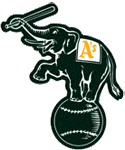 Alternate Logo 1995-Present |
Championship Teams
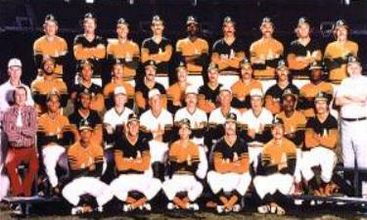 | 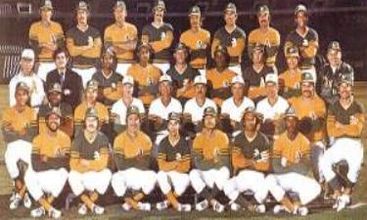 | 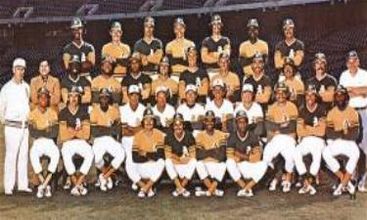 |
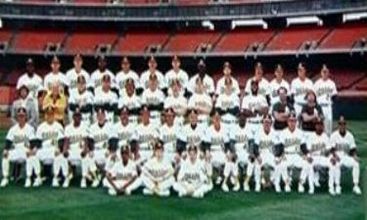 |
Athletics Stadiums
Swingin' A'S
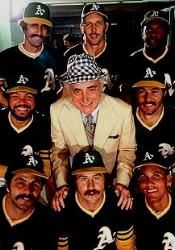 The Musttache Brigade & Charles O. Finley Owner 1968-1980 | 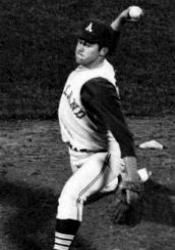 Jim “Catfish” Hunter 5/8/1968 Perfect Game | 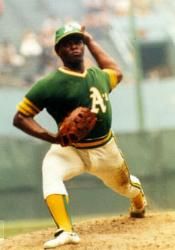 Vida Blue 1971 Cy Young & MVP | 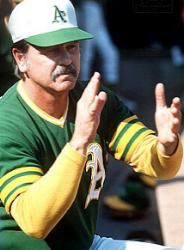 Dick Williams MGR 1971-1973 | 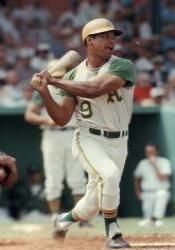 Reggie Jackson 1973 AL MVP & World Series MVP |  Dick Green 1968-1974 |
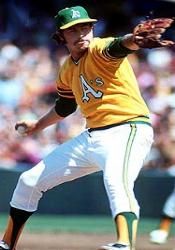 Jim “Catfish” Hunter 1968-1974 1974 Cy Young | 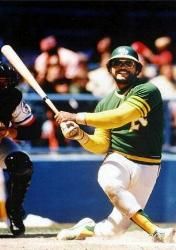 Reggie Jackson 1968-1975, 1987 | 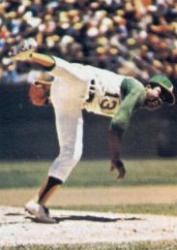 Blue Moon Odom 1968-1975 |  Ken Holtzman 1972-1975 |  Sal Bando 1968-1976 | 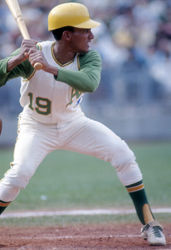 Bert Campaneris 1968-1976 |
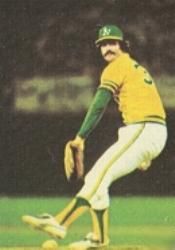 Rollie Fingers 1968-1976 1974 World Series MVP | 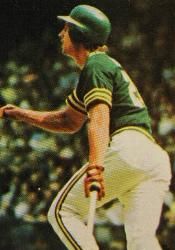 Joe Rudi 1968-1976 |  Gene Tenace 1969-1976 1972 World Series MVP | 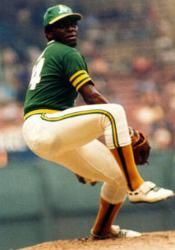 Vida Blue 1969-1977 | 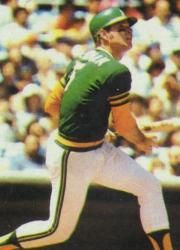 Jeff Newman 1976-1982 |  Tony Armas 1977-1982 |
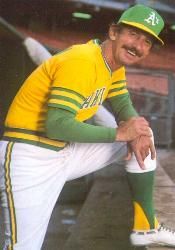 Billy Martin MGR 1980-1982 | 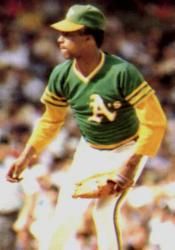 Mike Norris 1975-1983, 1990 |  Matt Keough 1977-1983 | 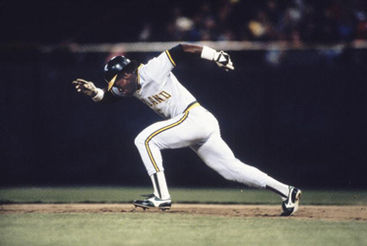 Rickey Henderson 1982: Record 130 SB |  Steve McCatty 1977-1985 | |
 Mike Heath 1979-1985 | 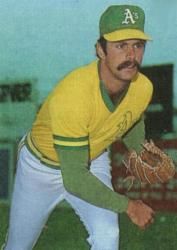 Rick Langford 1977-1986 | 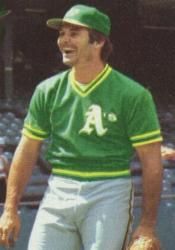 Dave Kingman 1984-1986 |  Dwayne Murphy 1978-1987 |  Mike Davis 1980-1987 | 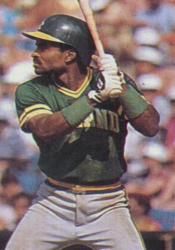 Tony Phillips 1982-1989, 1999 |
 “The Bash Brothers” Jose Canseco Mark McGwire 1986 Rookie of the Year 1987 |  Jose Canseco 1988 AL MVP, and 1st Player ever to hit 40 HR and steal 40 bases in the same season | 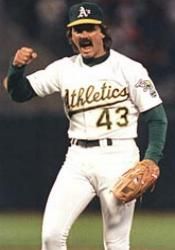 Dennis Eckersley 1988 ALCS MVP | 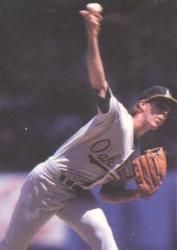 Storm Davis 1987-1989, 1993 | 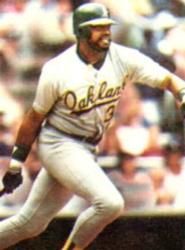 Dave Parker 1988-1989 | |
 Mike Gallego 1985-1991, 1995 | 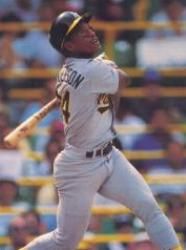 Rickey Henderson 1989 ALCS MVP 1990 AL MVP | 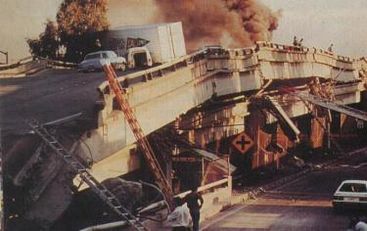 On October 17th a 6.8 Earthquake hit the Bay |  Dave Stewart 1989 World Series MVP 1990 ALCS MVP | 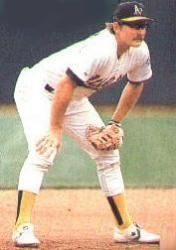 Carney Lansford 1983-1992 | |
 Jose Canseco 1985-1992, 1997 |  Dave Stewart 1986-1992, 1995 | 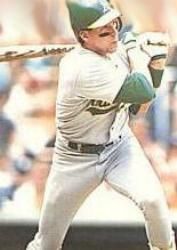 Walt Weiss 1987-1992 1988 Rookie of the Year | 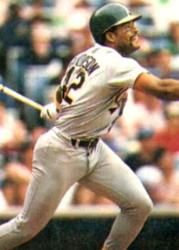 Dave Henderson 1988-1993 | 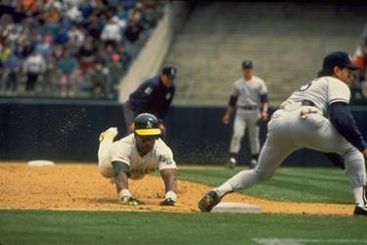 Rickey Henderson 5/1/1991 Rickey Henderson breaks the career record for SB with 939 | |
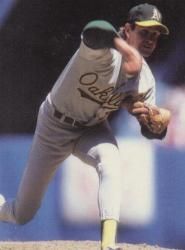 Bob Welch 1988-1994 1990 AL Cy Young |  Tony LaRussa MGR 1986-1995 |  Stan Javier 1986-1990, 1994-1995 |  Dennis Eckersley 1987-1995 1992 Cy Young & MVP | 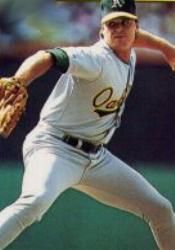 Rick Honeycutt 1987-1993, 1995 |  Ruben Sierra 1992-1995 |
 Terry Steinbach 1986-1996 | 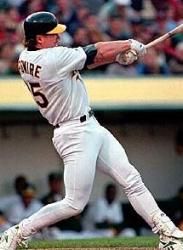 Mark McGwire 1986-1997 |  Geronimo Berroa 1994-1997 | 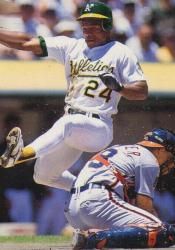 Rickey Henderson 1979-84, 1989-93, 1994-96, 98 | 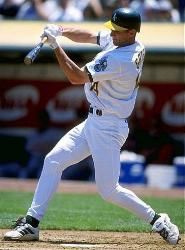 Ben Grieve 1997-2000 1998 Rookie of the Year |  Billy Beane GM 1998-Present |
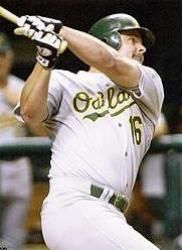 Jason Giambi 1995-2001, 2009 2000 AL MVP | 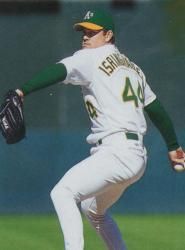 Jason Isringhausen 1999-2001 |  Billy Koch 2002 | 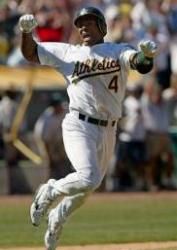 Miguel Tejada 1997-2003 2002 AL MVP |  Terrance Long 1999-2003 | 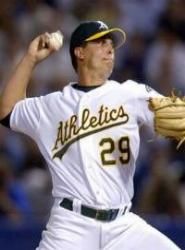 Keith Foulke 2003 |
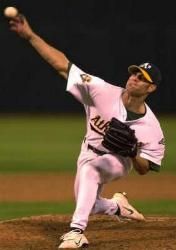 Tim Hudson 1999-2004 | 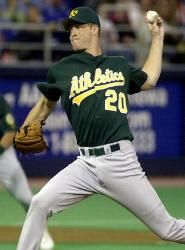 Mark Mulder 2000-2004 |  Jermaine Dye 2001-2004 | 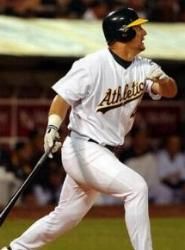 Erubiel Durazo 2003-2005 | 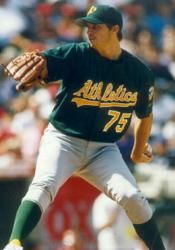 Barry Zito 2000-2006 2002 Cy Young |  Bobby Kielty 2004-2007 |
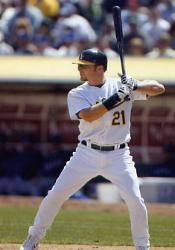 Mark Kotsay 2004-2007 | 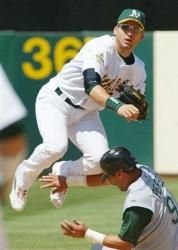 Marco Scutaro 2004-2007 | 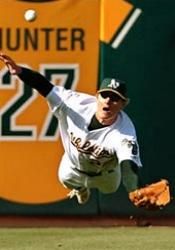 Eric Byrnes 2000-2005 |  Scott Hatteberg 2002-2005 | 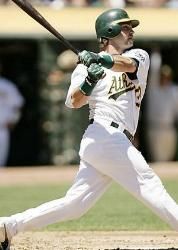 Nick Swisher 2004-2007 | 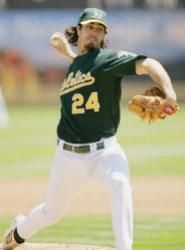 Dan Haren 2005-2007 |
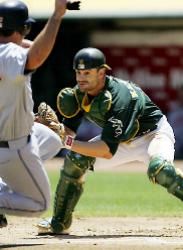 Jason Kendall 2005-2007 | 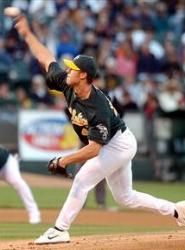 Rich Harden 2003-2008, 2011 | 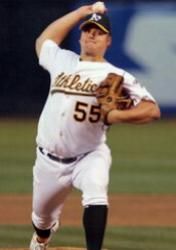 Joe Blanton 2004-2008 | 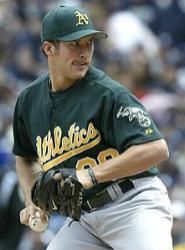 Huston Street 2005-2008 2005 Rookie of the Year | 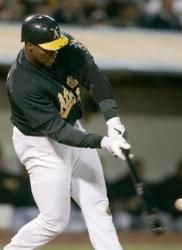 Frank Thomas 2006, 2008 | 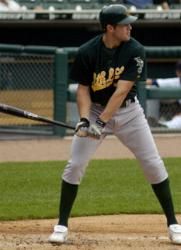 Bobby Crosby 2003-2009 2004 Rookie of the Year |
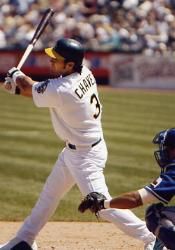 Eric Chavez 1998-2010 |  Justin Duchscherer 2003-2010 |  Jack Cust 2007-2010 | 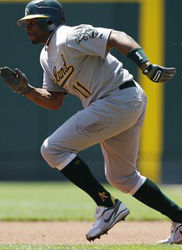 Rajai Davis 2008-2010 | 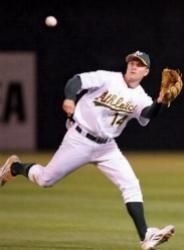 Mark Ellis 2002-2011 | 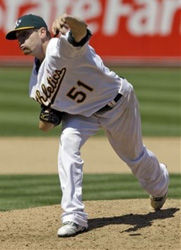 Dallas Braden 2007-2011 2009 Perfect Game |
 Gio Gonzalez 2008-2011 | 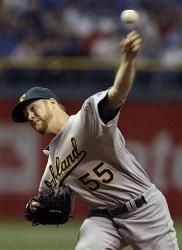 Josh Outman 2008-2011 |  Andrew Bailey 2009-2011 2009 Rookie of the Year |  Ryan Sweeney 2009-2011 | 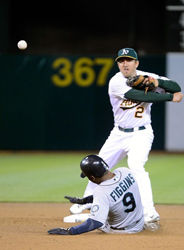 Cliff Pennington 2008-2012 | 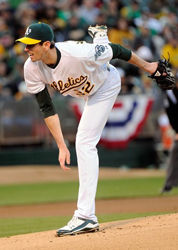 Brandon McCarthy 2011-2012 |
 Kurt Suzuki 2007-2012, 2013 | 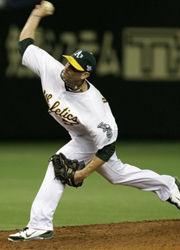 Grant Balfour 2011-2013 | 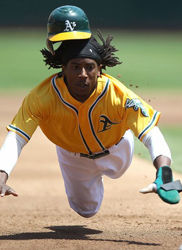 Jemile Weeks 2011-2013 |  Bartolo Colon 2012-2013 |  A.J. Griffin 2012-2013 | 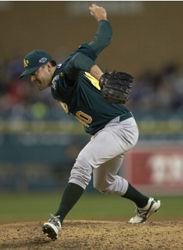 Pat Neshek 2012-2013 |
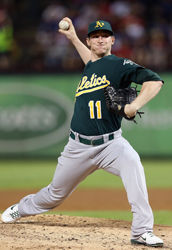 Jarrod Parker 2012-2013 | 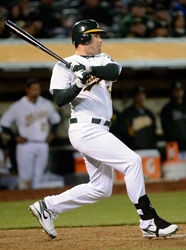 Seth Smith 2012-2013 | 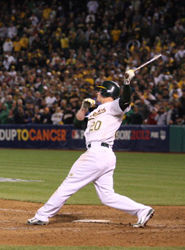 Josh Donaldson 2010, 2012-2014 | 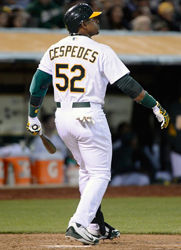 Yoenis Cespedes 2012-2014 |  Jonny Gomes 2012, 2014 | 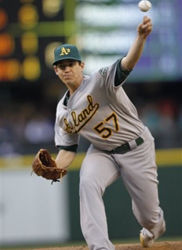 Tommy Milone 2012-2014 |
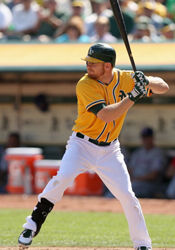 Brandon Moss 2012-2014 | 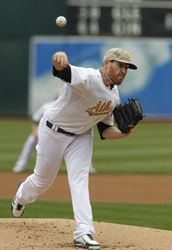 Dan Straily 2012-2014 | 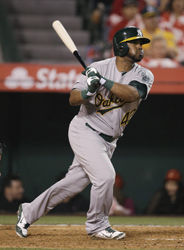 Alberto Callaspo 2013-2014 |  Jon Lester 2014 |  Jeff Samardzja 2014 | 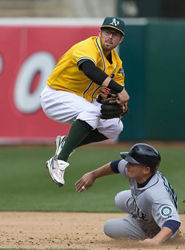 Eric Sogard 2010-2015 |
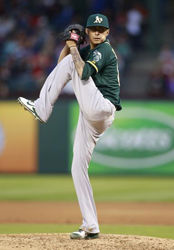 Jesse Chavez 2012-2015 |  Ryan Cook 2012-2015 |  Dan Otero 2013-2015 |  Scott Kazmir 2014-2015 | 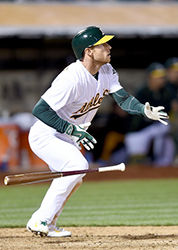 Brett Lawrie 2015 | 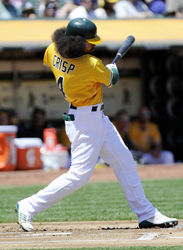 Coco Crisp 2010-2016 |
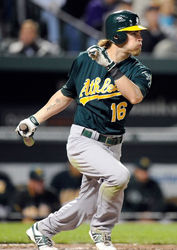 Josh Reddick 2012-2016 | 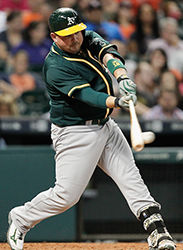 Billy Butler 2015-2016 | 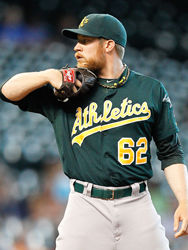 Sean Doolitle 2012-2017 |  Sonny Gray 2013-2017 |  Stephen Vogt 2013-2017 | 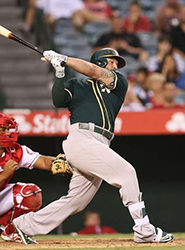 Yadier Alonso 2016-2017 |
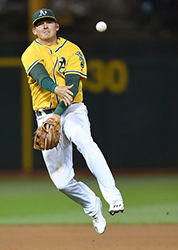 Ryon Healy 2016-2017 | 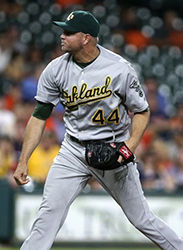 Ryan Madson 2016-2017 | 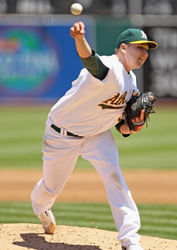 Trevor Cahill 2009-2011, 2018 | 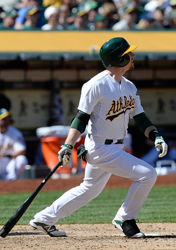 Jed Lowrie 2013-2014, 2016-2018 | 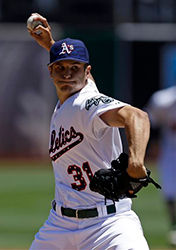 Kendall Graveman 2015-2018 | 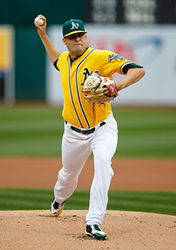 Andrew Triggs 2016-2018 |
 Brett Anderson 2009-2013, 2018-2019 | 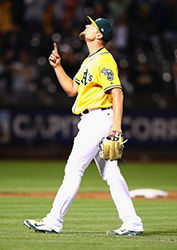 Blake Treinen 2017-2019 | 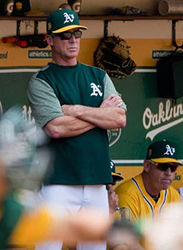 Bob Melvin MGR 2011-Present |  Chris Bassitt 2015-2016, 2018-Present |  Mark Canha 2015-Present | 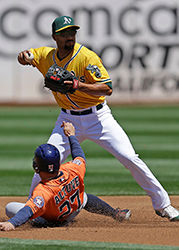 Marcus Semien 2015-Present |
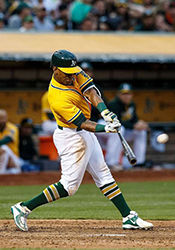 Khris Davis 2016-Present | 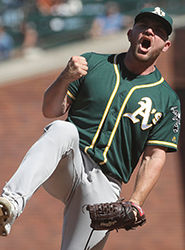 Liam Hendricks 2016-Present | 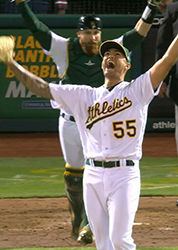 Sean Manaea 2016-Present |  Daniel Mengden 2016-Present | 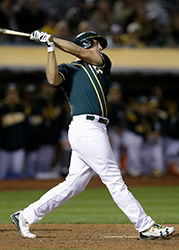 Matt Olson 2016-Present | 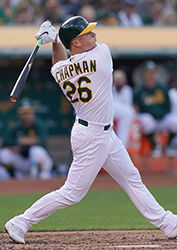 Matt Chapman 2017-Present |
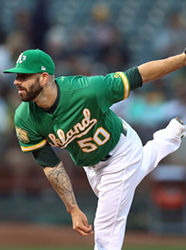 Mike Fiers 2018-Present | 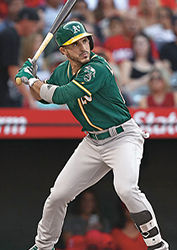 Ramon Laureano 2018-Present |  Stephen Piscotty 2018-Present | |||

